Quantifying Drought Characteristics in Complex Climate and Scarce Data Regions of Afghanistan
Abstract
:1. Introduction
2. Materials and Methods
2.1. Study Area and Data Used
2.2. Methodology
2.2.1. Identification of Homogeneous Regions
2.2.2. Selection of Suitable Probability Distribution Function (PDF)
2.2.3. Standardized Precipitation Index (SPI)
2.2.4. Analysis of Relationships between Regional Severe Drought and L-Moment Parameters
2.2.5. Drought Frequency Analysis
2.2.6. Drought Risk Assessment
2.2.7. Standardized Precipitation Deficit Distribution (SPDD)
Identification of Excess and Deficit Periods
Derivation of Uniformity Coefficient
Computation of Refined Deficit Aggregate
2.2.8. Drought IDF Analysis
3. Results
3.1. Identification of Homogeneous Regions
3.1.1. Homogeneous Regions
3.1.2. Homogeneity Test
3.2. Selection of a Suitable PDF
3.3. Standardized Precipitation Index
3.4. Regional Drought Severity Relation to L-Moment Parameters
3.5. Drought Frequency Analysis
3.5.1. Percentage of Dry Years
3.5.2. Drought Severity and Return Period
3.5.3. Drought Duration and Frequency
3.6. Drought Risk Analysis
3.7. Drought Magnitude Distribution
3.8. Drought IDF Analysis
4. Discussion
5. Conclusions
Author Contributions
Funding
Data Availability Statement
Conflicts of Interest
References
- Hosseini, A.; Ghavidel, Y.; Farajzadeh, M. Characterization of drought dynamics in Iran by using S-TRACK method. Theor. Appl. Climatol. 2021, 10, 1007. [Google Scholar] [CrossRef]
- Sa’adi, Z.; Shahid, S.; Ismail, T.; Chung, E.S.; Wang, X.J. Distributional changes in rainfall and river flow in Sarawak, Malaysia. Asia Pac. J. Atmos. Sci 2017, 53, 489–500. [Google Scholar] [CrossRef]
- Ahmed, K.; Shahid, S.; Chung, E.S.; Ismail, T.; Wang, X.J. Spatial distribution of secular trends in annual and seasonal precipitation over Pakistan. Clim. Res. 2017, 74, 95–107. [Google Scholar] [CrossRef]
- Hadi Pour, S.; AbdWahab, A.K.; Shahid, S.; Wang, X. Spatial Pattern of the Unidirectional Trends in Thermal Bioclimatic Indicators in Iran. Sustainability 2019, 11, 2287. [Google Scholar] [CrossRef]
- ND-GAIN—Notre Dame Global Adaptation Initiative. “Afghanistan”. 2021. Available online: https://gain-new.crc.nd.edu/country/afghanistan (accessed on 6 November 2021).
- Sarhadi, A.; Heydarizadeh, M. Regional frequency analysis and spatial pattern characterization of dry spells in Iran. Int. J. Clim. 2014, 34, 835–848. [Google Scholar] [CrossRef]
- Kaluba, P.; Verbist, K.M.J.; Cornelis, W.M.; Van Ranst, E. Spatial mapping of drought in Zambia using regional frequency analysis. Hydrol. Sci. J. 2017, 13, 43475. [Google Scholar] [CrossRef]
- Núñez, J.H.; Verbist, K.; Wallis, J.R.; Schaefer, M.G.; Morales, L.; Cornelis, W.M. Regional frequency analysis for mapping drought events in north-central Chile. J. Hydrol. 2011, 405, 352–366. [Google Scholar] [CrossRef]
- Hosking, J.; Wallis, J. Contents in Regional Frequency Analysis: An Approach Based on L-Moments; Cambridge University Press: Cambridge, UK, 1997. [Google Scholar]
- Santos, J.F.; Portela, M.M.; Pulido-Calvo, I. Regional frequency analysis of droughts in Portugal. Water Resour. Manag. 2011, 25, 3537–3558. [Google Scholar] [CrossRef]
- Modarres, R. Regional dry spells frequency analysis by L-Moment and multivariate analysis. Water Resour. Manag. 2010, 24, 2365–2380. [Google Scholar] [CrossRef]
- Yoo, J.; Kwon, H.-H.; Kim, T.-W.; Ahn, J.-H. Drought frequency analysis using cluster analysis and bivariate probability distribution. J. Hydrol. 2012, 1, 102–111. [Google Scholar] [CrossRef]
- Zhang, Q.; Qi, T.; Singh, V.P.; Chen, Y.D.; Xiao, M. Regional frequency analysis of droughts in China: A multivariate perspective. Water Resour. Manag. 2015, 29, 1767–1787. [Google Scholar] [CrossRef]
- Núñez, J.; Hallack-Alegría, M.; Cadena, M. Resolving regional frequency analysis of precipitation at large and complex scales using a bottom-up approach: The Latin America and the Caribbean Drought Atlas. J. Hydrol. 2016, 538, 515–538. [Google Scholar] [CrossRef]
- Palmer, W.C. Meteorological Drought; U.S. Dept. of Commerce: Washington, DC, USA, 1965; Rep. 45; p. 58. [Google Scholar]
- Palmer, W.C. Keeping Track of Crop Moisture Conditions, Nationwide: The New Crop Moisture Index. Weatherwise 1968, 21, 156–161. [Google Scholar] [CrossRef]
- McKee, T.B.; Doesken, N.J.; Kleist, J. The relationship of drought frequency and duration to time scales. In Proceedings of the 8th Conference on Applied Climatology; Anaheim, CA, USA, 17–22 January 1993, Volume 17, No. 22.
- Mckee, T.B. Drought monitoring with multiple timescales. In Proceedings of the Ninth Conference on Applied Climatology, Dallas, TX, USA, 15–20 January 1995; Boston American Meteorological Society: Boston, MA, USA; pp. 233–236. [Google Scholar]
- Sohrabi, M.M.; Ryu, J.H.; Abatzoglou, J.; Tracy, J. Development of Soil Moisture Drought Indexto Characterize Droughts. J. Hydrol. Eng. 2015, 20, 04015025-1. [Google Scholar] [CrossRef]
- Quiring, S.M.; Ganesh, S. Evaluating the utility of the Vegetation Condition Index (VCI) for monitoring meteorological drought in Texas. J. Agric. For. Meteorol. 2010, 150, 330–333. [Google Scholar] [CrossRef]
- Beguería, S.; Vicente-Serrano, S.M.; Reig, F.; Latorre, B. Standardized precipitation evapotranspiration index (SPEI) revisited: Parameter fitting, evapotranspiration models, tools, datasets and drought monitoring. Int. J. Climatol. 2014, 34, 3001–3023. [Google Scholar] [CrossRef]
- Hoekema, D.J.; Sridhar, V. Relating climatic attributes and water resources allocation: A study using surface water supply and soil moisture indices in the Snake River basin, Idaho. Water Resour. Res. 2011, 47, 536. [Google Scholar] [CrossRef]
- Wu, H.; Hayes, M.J.; Wilhite, D.A.; Svoboda, M.D. The Effect of the Length of Record on the Standardized Precipitation Index Calculation. Int. J. Clim. 2005, 25, 505–520. [Google Scholar] [CrossRef]
- Aksoy, H.; Cavus, Y. Discussion of “Drought assessment in a south Mediterranean transboundary catchment”. Hydrol. Sci. J. 2022, 67, 150–156. [Google Scholar] [CrossRef]
- Yu, J.; Kim, J.E.; Lee, J.-H.; Kim, T.-W. Development of a PCA-Based Vulnerability and Copula-Based Hazard Analysis for Assessing Regional Drought Risk. J. Civ. Eng. 2021, 25, 1901–1908. [Google Scholar] [CrossRef]
- Intergovernmental Panel on Climate Change. Managing the Risks of Extreme Events and Disasters to Advance Climate Change Adaptation: Summary for Policymakers; Cambridge University Press: Cambridge, UK, 2012; pp. 1–19. [Google Scholar]
- Kim, H.; Park, J.; Yoo, J.; Kim, T.-W. Assessment of drought hazard, vulnerability, and risk: A case study for administrative districts in South Korea. J. Hydro-Environ. Res. 2015, 9, 28–35. [Google Scholar] [CrossRef]
- Carrão, H.; Naumann, G.; Barbosa, P. Mapping global patterns of drought risk: An empirical framework based on sub-national estimates of hazard, exposure and vulnerability. Glob. Environ. Chang. 2016, 39, 108–124. [Google Scholar] [CrossRef]
- Hinkel, J. “Indicators of vulnerability and adaptive capacity”: Towards a clarification of the science-policy interface. Glob. Environ. Chang. 2011, 21, 198–208. [Google Scholar] [CrossRef]
- Shahid, S.; Behrawan, H. Drought risk assessment in the western part of Bangladesh. Nat. Hazards 2008, 46, 391–413. [Google Scholar] [CrossRef]
- Lin, M.L.; Chu, C.M.; Tsai, B.W. Drought risk assessment in western Inner-Mongolia. Int. J. Environ. Res. 2011, 5, 139–148. [Google Scholar] [CrossRef]
- Aksoy, H.; Cetin, M.; Eris, E.; Burgan, H.I.; Cavus, Y.; Yildirim, I.; Sivapalan, M. Critical drought intensity-duration-frequency curves based on total probability theorem-coupled frequency analysis. Hydrol. Sci. J. 2021, 66, 1337–1358. [Google Scholar] [CrossRef]
- Cavus, Y.; Aksoy, H. Critical drought severity and intensity-duration-frequency curves based on precipitation deficit. J. Hydrol. 2020, 584, 124312. [Google Scholar] [CrossRef]
- Satish Kumar, K.; AnandRaj, P.; Sreelatha, K.; Sridhar, V. Regional analysis of drought severity-duration-frequency and severity-area-frequency curves in the Godavari River Basin, India. Int. J. Clim. 2021, 41, 5481–5501. [Google Scholar] [CrossRef]
- Mishra, A.K.; Singh, V.P. Analysis of drought severity-area-frequency curves using a general circulation model and scenario uncertainty. J. Geophys. Res. 2009, 114, D06120. [Google Scholar] [CrossRef]
- Dalezios, N.R.; Loukas, A.; Vasiliades, L.; Liakopoulos, E. Severity-duration-frequency analysis of droughts and wet periods in Greece. Hydrol. Sci. J. 2000, 45, 751–769. [Google Scholar] [CrossRef]
- Sediqi, M.N.; Shiru, M.S.; Nashwan, M.S.; Ali, R.; Abubaker, S.; Wang, X.; Ahmed, K.; Shahid, S.; Asaduzzaman, M.; Manawi, S.M.A. Spatiotemporal pattern in the changes in availability and sustainability of water resources in Afghanistan. Sustainability 2019, 11, 5836. [Google Scholar] [CrossRef]
- Qureshi, A.S. Water Resources Management in Afghanistan: The Issues and Options; Researchgate; International Water Management Institute: Islamabad, Pakistan, 2002; p. 42765588. [Google Scholar]
- Qutbudin, I.; Shiru, M.S.; Sharafati, A.; Ahmed, K.; Al-Ansari, N.; Yaseen, Z.M.; Shahid, S.; Wang, X. Seasonal Drought Pattern Changes Due to Climate Variability: Case Study in Afghanistan. Water 2019, 11, 1096. [Google Scholar] [CrossRef]
- Alam, A.; Emura, K.; Farnham, C.; Yuan, J. Best-Fit Probability Distributions and Return Periods for Maximum Monthly Rainfall in Bangladesh. Climate 2018, 6, 9. [Google Scholar] [CrossRef]
- Poornima, S.; Pushpalatha, M.; Jana, R.B.; Patti, L.A. Rainfall Forecast and Drought Analysis for Recent and Forthcoming Years in India. Water 2023, 15, 592. [Google Scholar] [CrossRef]
- Sirdaş, S.; Sen, Z. Spatio-temporal drought analysis in the Trakya region, Turkey. Hydrol. Sci. J. 2003, 48, 809–820. [Google Scholar] [CrossRef]
- Subramanya, K. Engineering Hydrology, 3rd ed.; Tata McGraw-Hill Publishing Company Limited: New Delhi, India, 2008; pp. 254–261. [Google Scholar]
- Wisner, B.; Blaikie, P.; Cannon, T.; Davis, I. At Risk: Natural Hazards, People Vulnerability, and Disasters; Routledge Publisher: London, UK, 1994; pp. 1–471. [Google Scholar]
- Rajsekhar, D.; Singh, V.P.; Mishra, A.K. Integrated drought causality, hazard, and vulnerability assessment for future socioeconomic scenarios: An information theory perspective. J. Geophys. Atmos. 2015, 120, 6346–6378. [Google Scholar] [CrossRef]
- Zhang, Q.; Sun, P.; Li, J.; Xiao, M.; Singh, V.P. Assessment of drought vulnerability of the Tarim River basin, Xinjiang, China. Theor. Appl. Climatol. 2014, 121, 337–347. [Google Scholar] [CrossRef]
- Bogardi, J.; Birkmann, J. Vulnerability assessment: The first step towards sustainable risk reduction. In Disaster and Society—From Hazard Assessment to Risk Reduction; Malzahn, D., Plapp, T., Eds.; Logos Verlag Berlin: Berlin, Germany, 2004; pp. 75–82. [Google Scholar]
- Shiru, M.S.; Shahid, S.; Park, I. Projection of Water Availability and Sustainability in Nigeria Due to Climate Change. Sustainability 2021, 13, 6284. [Google Scholar] [CrossRef]
- Singh, G.R.; Dhanya, C.T.; Chakravorty, A. A robust drought index accounting changing precipitation characteristics. Water Resour. Res. 2021, 57, e2020WR029496. [Google Scholar] [CrossRef]
- Chow, V.T.; Maidment, D.R.; Larry, W. Mays. Applied Hydrology; McGraw-Hill International Edition: New York, NY, USA, 1988; p. 339. [Google Scholar]
- Adamson, D.; Loch, A.; Schwabe, K. Adaptation responses to increasing drought frequency. Aust. J. Agric. Resour. Econ. 2017, 61, 385–403. [Google Scholar] [CrossRef]
- Quiggin, J.; Chambers, R. The state-contingent approach to production under uncertainty. Aust. J. Agric. Resour. Econ. 2006, 50, 153–169. [Google Scholar] [CrossRef]
- Zhiltsov, S.S.; Zhiltsova, M.S.; Medvedev, N.P.; Slizovskiy, D.Y. Water Resources of Central Asia: Historical Overview. In Water Resources in Central Asia: International Context; Springer International Publishing: Berlin/Heidelberg, Germany, 2018; pp. 9–24. [Google Scholar]
- Mishra, A.K.; Singh, V.P. Drought modeling—A review. J. Hydrol. 2011, 403, 157–175. [Google Scholar] [CrossRef]
- Shahid, S.; Pour, S.H.; Wang, X.; Shourav, S.A.; Minhans, A.; Ismail, T.b. Impacts and adaptation to climate change in Malaysian real estate. Int. J. Clim. Chang. Strateg. Manag. 2017, 9, 87–103. [Google Scholar] [CrossRef]


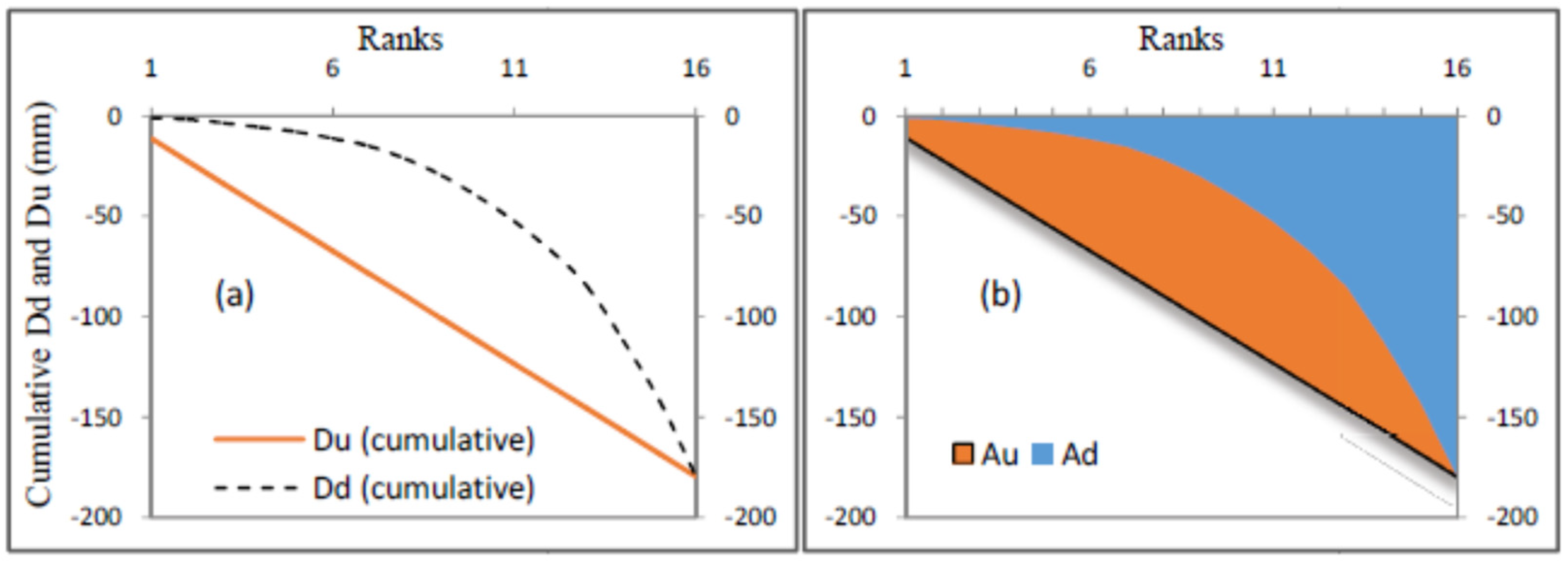
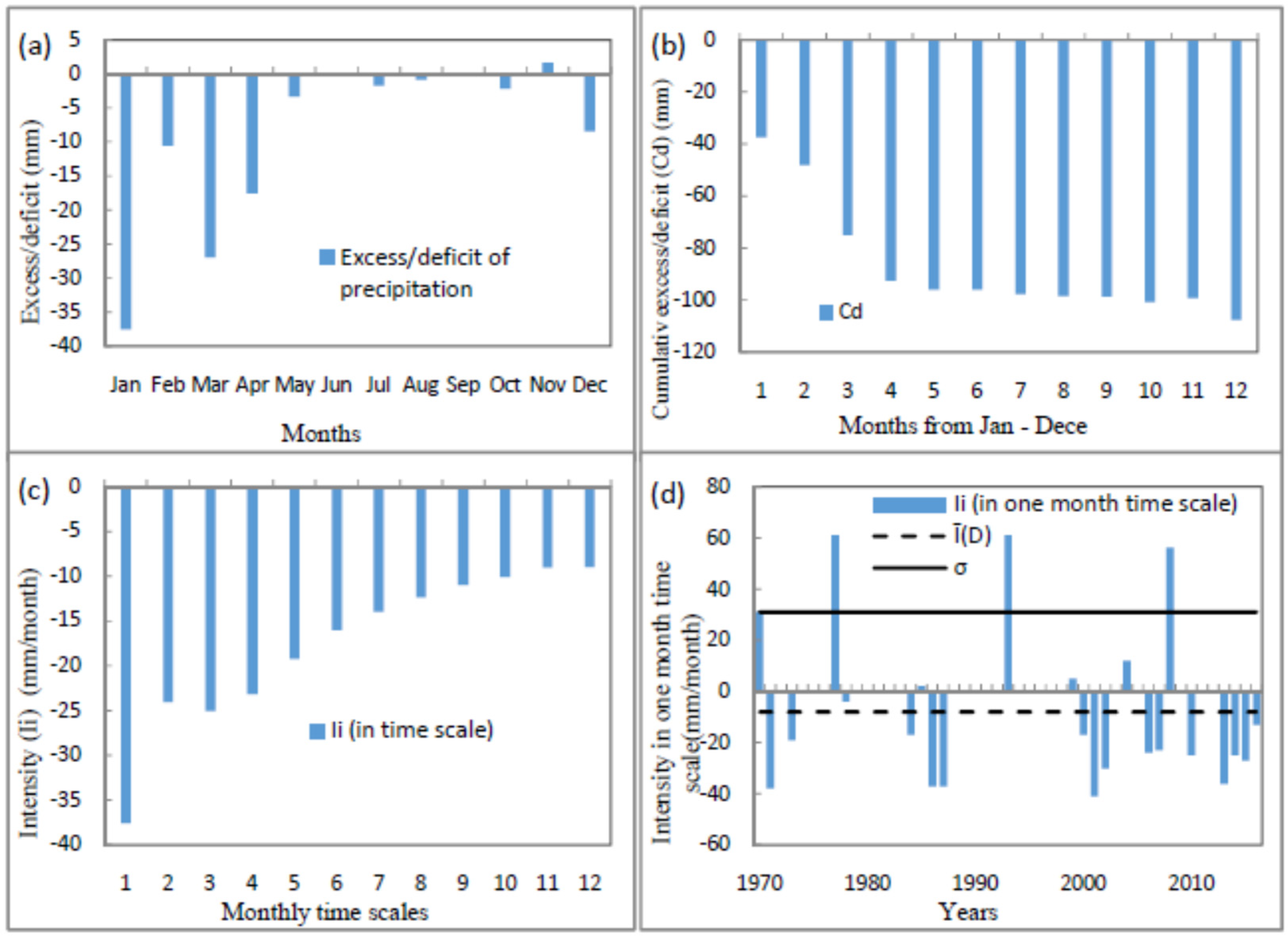

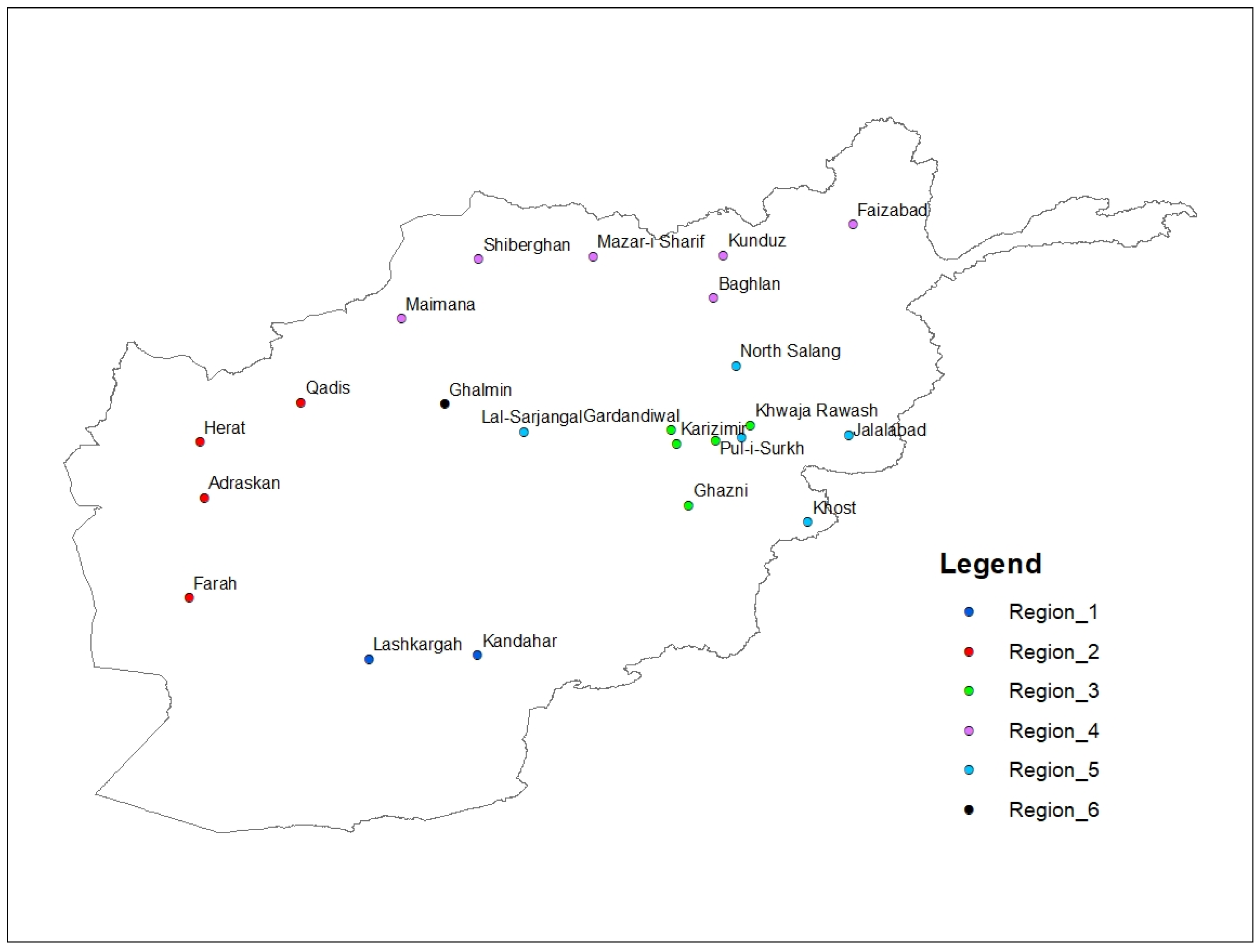



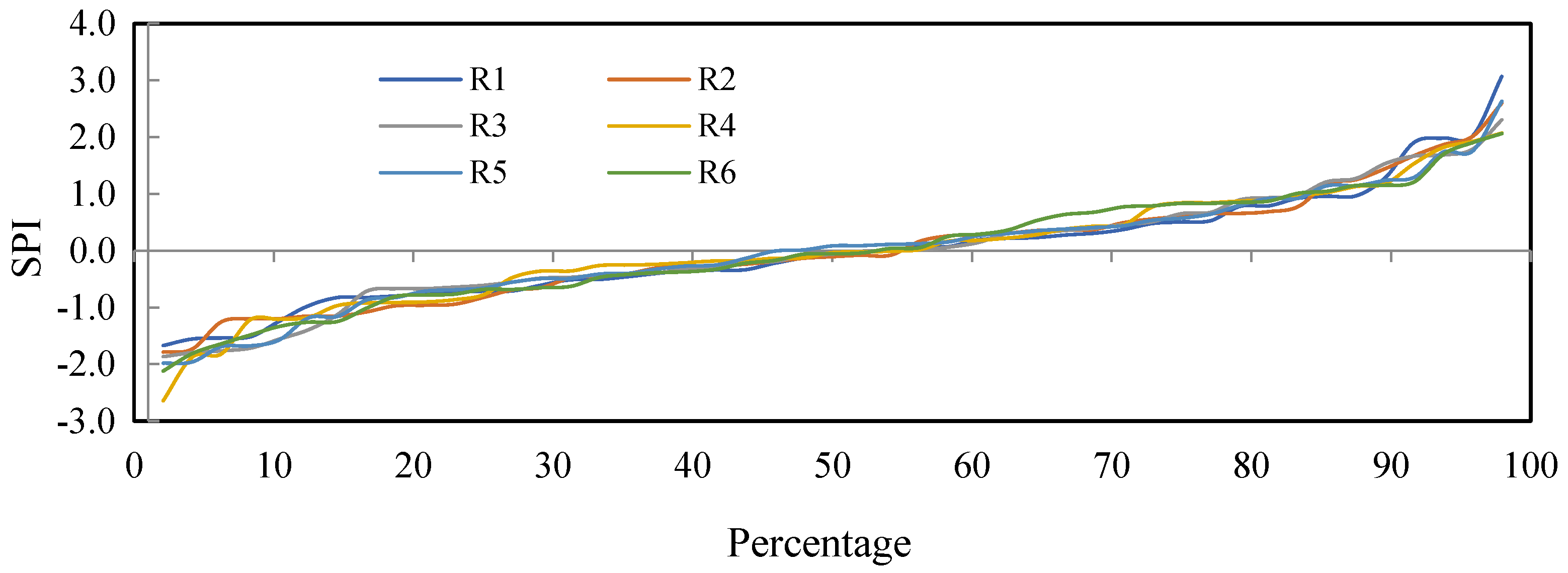
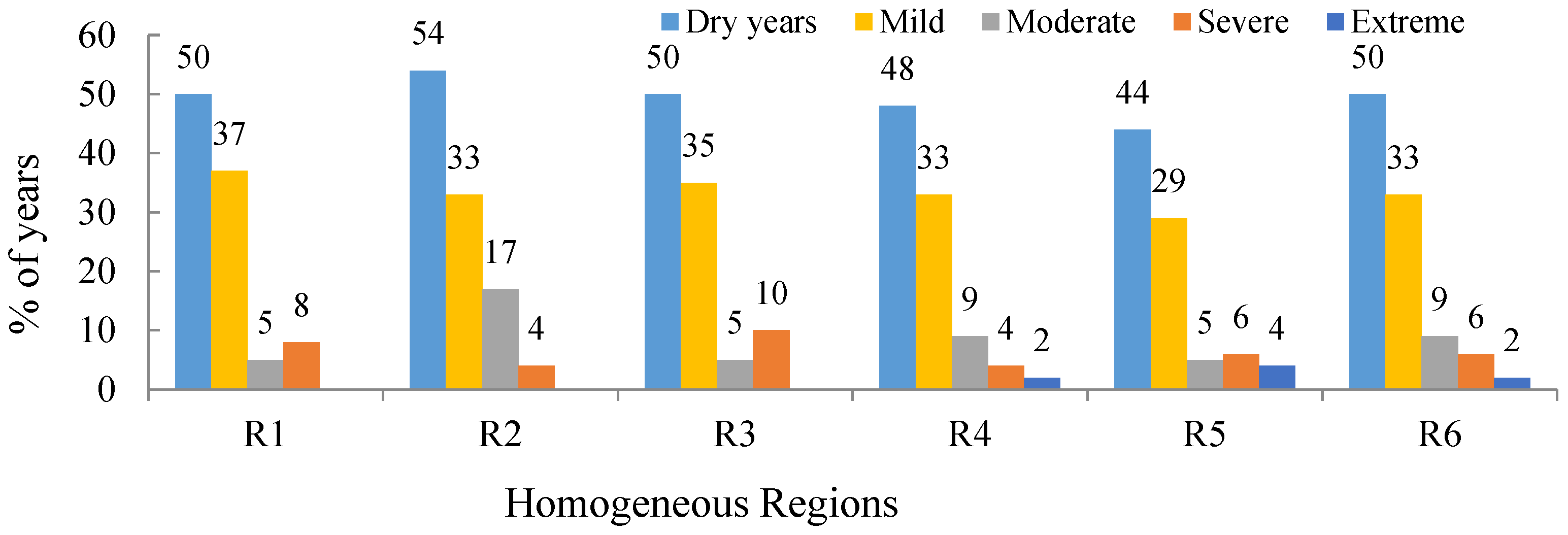
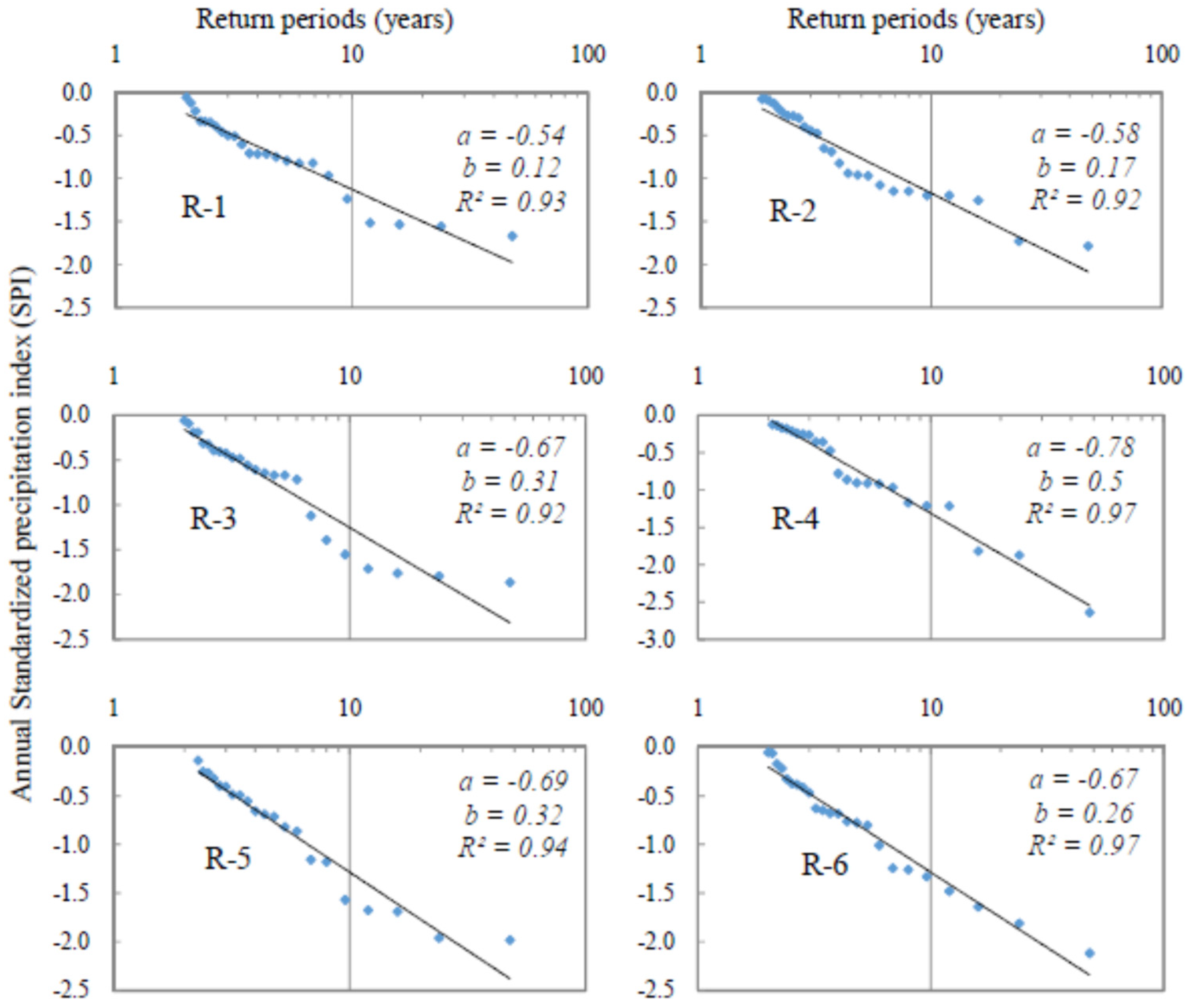

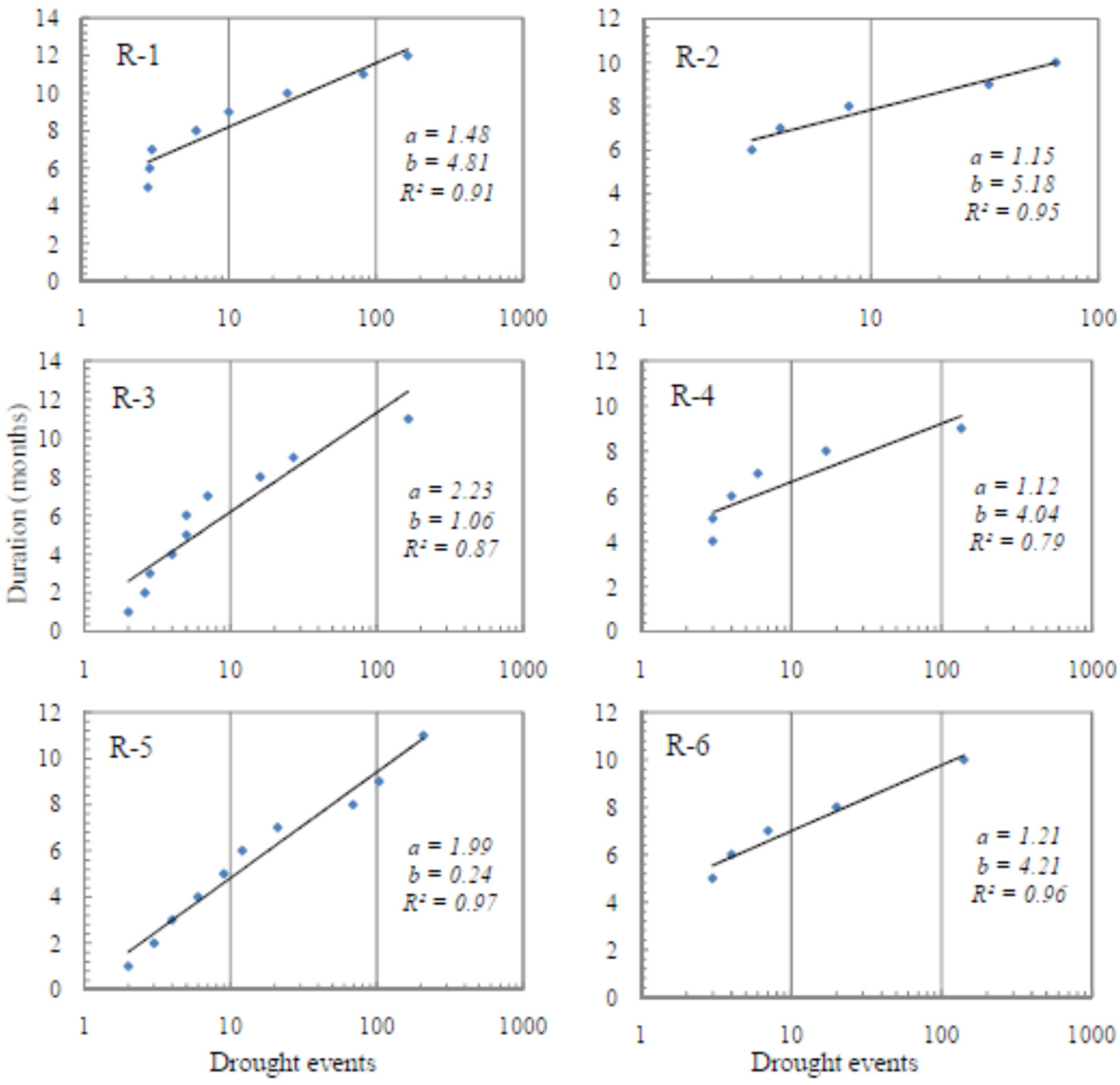

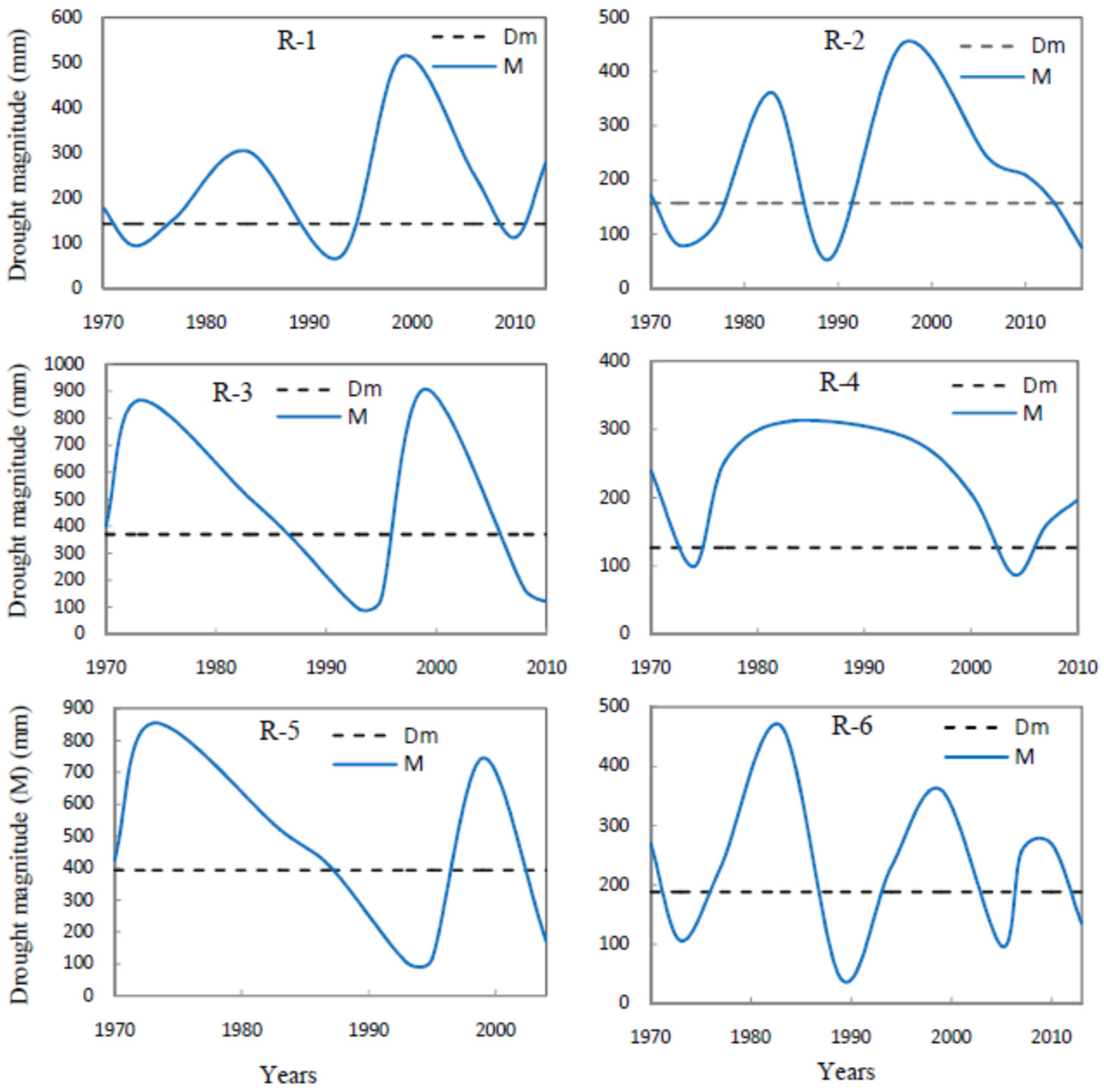
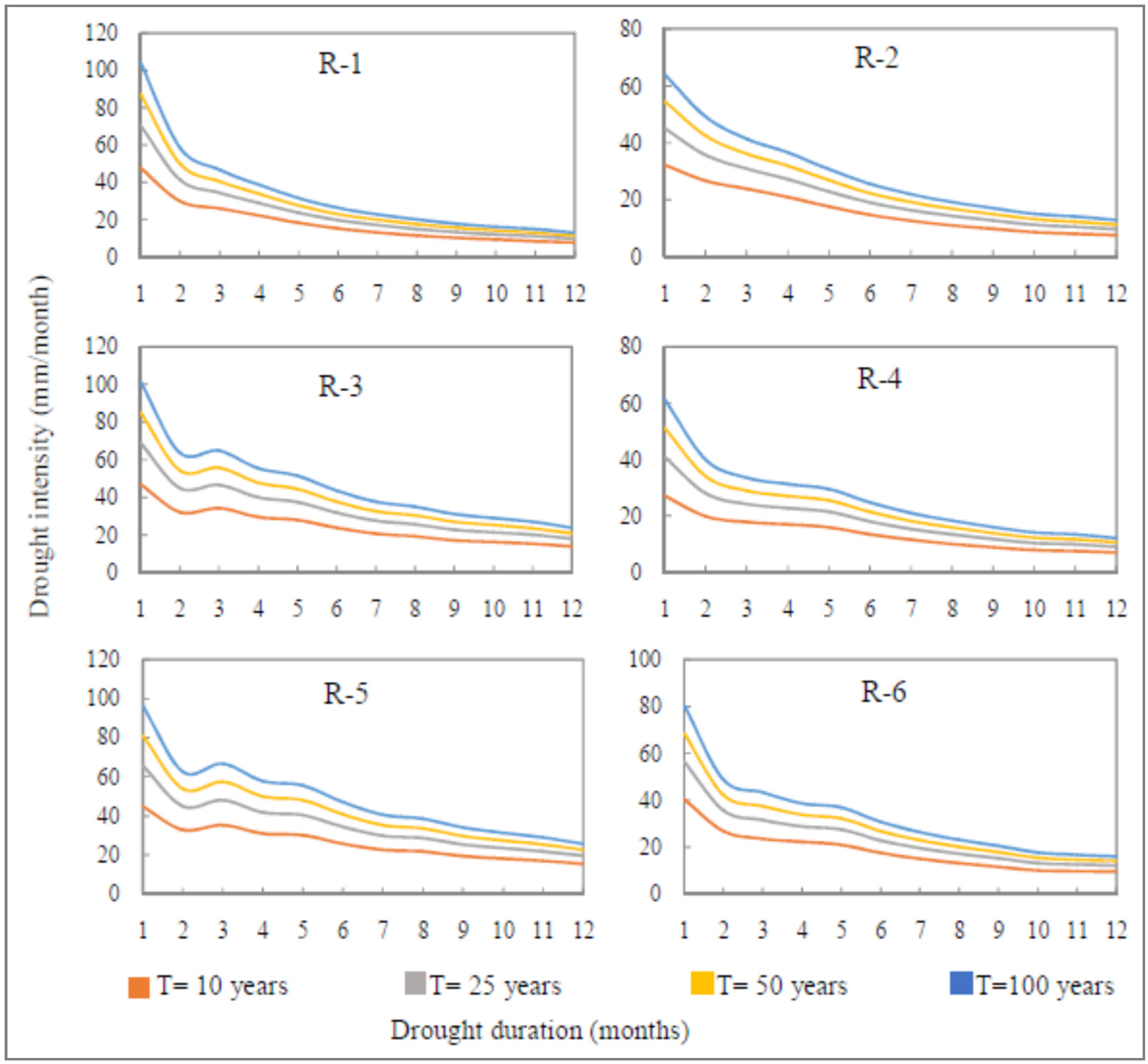
| Categories | SPI Range |
|---|---|
| Extreme drought | SPI ≤ −2 |
| Severe drought | −2 < SPI ≤ −1.5 |
| Moderate drought | −1.5 < SPI ≤ −1 |
| Mild drought | −1 < SPI < 0 |
| Mild wet | 0 ≤ SPI < 1 |
| Moderate wet | 1 ≤ SPI < 1.5 |
| Severe wet | 1.5 ≤ SPI < 2 |
| Extreme wet | 2 ≤ SPI |
| Rank | Duration (Months) | Intensity (mm) | Weight (rk) | |
|---|---|---|---|---|
| 1 | 3 | 1.0 | moderate | 0.1 |
| 2 | 6 | 0.2 | ||
| 3 | 12 | 0.3 | ||
| 4 | 3 | 1.5 | severe | 0.4 |
| 5 | 6 | 0.6 | ||
| 6 | 12 | 0.7 | ||
| 7 | 3 | 2.0 | extreme | 0.8 |
| 8 | 6 | 0.9 | ||
| 9 | 12 | 1 | ||
| Regions | Station No. | Station Name | MAP (mm) | SD | τ2 | τ3 | τ4 | Di |
|---|---|---|---|---|---|---|---|---|
| R-1 | 1 | Lashkargah | 150 | 59 | −0.06 | 0.95 | −0.61 | 0.101 |
| 2 | Kandahar | 198 | 81 | −0.04 | 1.39 | −1.42 | 0.153 | |
| R-2 | 3 | Farah | 152 | 60 | −0.07 | 0.54 | −0.27 | 0.038 |
| 4 | Adraskan | 228 | 70 | −0.05 | 0.24 | −0.53 | 0.001 | |
| 5 | Herat | 236 | 73 | −0.05 | 0.20 | −0.48 | 0.001 | |
| 6 | Qadis | 272 | 76 | −0.04 | 0.00 | −0.64 | 0.008 | |
| R-3 | 7 | Ghazni | 451 | 110 | 0.98 | −0.87 | 0.96 | 0.243 |
| 8 | Karizimir | 484 | 111 | 0.99 | −0.86 | 0.94 | 0.247 | |
| 9 | Pul-i-Surkh | 491 | 115 | 1.00 | −0.85 | 0.93 | 0.248 | |
| 10 | Gardandiwal | 493 | 108 | 0.98 | −0.88 | 0.95 | 0.247 | |
| 11 | KhwajaRawash | 505 | 116 | 0.99 | −0.86 | 0.94 | 0.247 | |
| R-4 | 12 | Shiberghan | 208 | 39 | 0.03 | −0.12 | 0.33 | 0.000 |
| 13 | Mazar-i-Sharif | 242 | 45 | 0.04 | −0.12 | 0.38 | 0.000 | |
| 14 | Maimana | 281 | 58 | 0.01 | −0.01 | 1.18 | 0.024 | |
| 15 | Kunduz | 335 | 63 | 0.04 | −0.18 | 0.54 | 0.000 | |
| 16 | Baghlan | 349 | 67 | 0.04 | −0.13 | 0.50 | 0.001 | |
| 17 | Faizabad | 522 | 91 | 0.02 | −0.24 | 0.89 | 0.000 | |
| R-5 | 18 | Lal-Sarjangal | 349 | 81 | 0.03 | 0.30 | 1.16 | 0.081 |
| 19 | North Salang | 547 | 111 | 0.05 | 0.18 | 0.55 | 0.023 | |
| 20 | Tang-i-Sayedan | 563 | 136 | 0.07 | 0.28 | 0.38 | 0.030 | |
| 21 | Khost | 595 | 130 | 0.06 | 0.36 | 0.46 | 0.047 | |
| 22 | Jalalabad | 689 | 148 | 0.06 | 0.37 | 0.40 | 0.045 | |
| R-6 | 23 | Ghalmin | 337 | 75 | 0.00 | 478.34 | −1493.48 | 5.882 |
| Regions | No of Stations | Abs (H) | Homogeneity Type |
|---|---|---|---|
| R-1 | 2 | 0.49 | Homogeneous |
| R-2 | 4 | 0.55 | Homogeneous |
| R-3 | 5 | 0.41 | Homogeneous |
| R-4 | 6 | 0.79 | Homogeneous |
| R-5 | 5 | 0.44 | Homogeneous |
| R-6 | 1 | 1.86 | Possibly heterogeneous |
| Month Scale | R-1 | R-2 | R-3 | R-4 | R-5 | R-6 | ||||||
|---|---|---|---|---|---|---|---|---|---|---|---|---|
| a | b | a | b | a | b | a | b | a | b | a | b | |
| 1 | 25.86 | −13.78 | 14.6 | −2.42 | 24.98 | −12.53 | 15.77 | −10.27 | 23.73 | −11.6 | 18.43 | −3.43 |
| 2 | 13.14 | −1.34 | 10.37 | 1.97 | 14.53 | −2.41 | 9.26 | −2.1 | 13.66 | 0.51 | 10.1 | 2.84 |
| 3 | 9.516 | 3.41 | 8.04 | 4.79 | 14 | 0.97 | 7.26 | 0.63 | 14.43 | 1.1 | 9.05 | 2.17 |
| 4 | 7.57 | 4.32 | 7.2 | 3.88 | 11.93 | 1.13 | 6.6 | 1.38 | 12.39 | 1.52 | 7.49 | 4.55 |
| 5 | 6.14 | 3.71 | 6.03 | 3.34 | 10.78 | 2.41 | 6.22 | 1.32 | 11.72 | 2.3 | 7.32 | 3.72 |
| 6 | 5.11 | 3.09 | 5.03 | 2.78 | 9.06 | 2.38 | 5.22 | 1.14 | 9.81 | 2.48 | 6.1 | 3.1 |
| 7 | 4.43 | 2.69 | 4.31 | 2.39 | 7.78 | 2.27 | 4.38 | 1.22 | 8.26 | 3.1 | 5.23 | 2.66 |
| 8 | 3.89 | 2.35 | 3.77 | 2.08 | 7.25 | 2.11 | 3.81 | 1.13 | 7.7 | 3.59 | 4.57 | 2.33 |
| 9 | 3.46 | 2.09 | 3.35 | 1.85 | 6.41 | 1.99 | 3.32 | 1.1 | 6.71 | 3.54 | 4.06 | 2.07 |
| 10 | 3.12 | 2.04 | 2.94 | 1.73 | 5.87 | 2.38 | 2.89 | 1.16 | 6.1 | 3.81 | 3.52 | 1.78 |
| 11 | 2.91 | 1.67 | 2.79 | 1.44 | 5.34 | 2.73 | 2.67 | 1.36 | 5.48 | 4.05 | 3.21 | 2.14 |
| 12 | 2.32 | 2.34 | 2.39 | 2 | 4.55 | 3.2 | 2.4 | 1.39 | 4.71 | 4.32 | 2.97 | 2.51 |
Disclaimer/Publisher’s Note: The statements, opinions and data contained in all publications are solely those of the individual author(s) and contributor(s) and not of MDPI and/or the editor(s). MDPI and/or the editor(s) disclaim responsibility for any injury to people or property resulting from any ideas, methods, instructions or products referred to in the content. |
© 2023 by the authors. Licensee MDPI, Basel, Switzerland. This article is an open access article distributed under the terms and conditions of the Creative Commons Attribution (CC BY) license (https://creativecommons.org/licenses/by/4.0/).
Share and Cite
Dost, R.; Soundharajan, B.-S.; Kasiviswanathan, K.S.; Patidar, S. Quantifying Drought Characteristics in Complex Climate and Scarce Data Regions of Afghanistan. Geosciences 2023, 13, 355. https://doi.org/10.3390/geosciences13120355
Dost R, Soundharajan B-S, Kasiviswanathan KS, Patidar S. Quantifying Drought Characteristics in Complex Climate and Scarce Data Regions of Afghanistan. Geosciences. 2023; 13(12):355. https://doi.org/10.3390/geosciences13120355
Chicago/Turabian StyleDost, Rahmatullah, Bankaru-Swamy Soundharajan, Kasiapillai S. Kasiviswanathan, and Sandhya Patidar. 2023. "Quantifying Drought Characteristics in Complex Climate and Scarce Data Regions of Afghanistan" Geosciences 13, no. 12: 355. https://doi.org/10.3390/geosciences13120355
APA StyleDost, R., Soundharajan, B.-S., Kasiviswanathan, K. S., & Patidar, S. (2023). Quantifying Drought Characteristics in Complex Climate and Scarce Data Regions of Afghanistan. Geosciences, 13(12), 355. https://doi.org/10.3390/geosciences13120355










